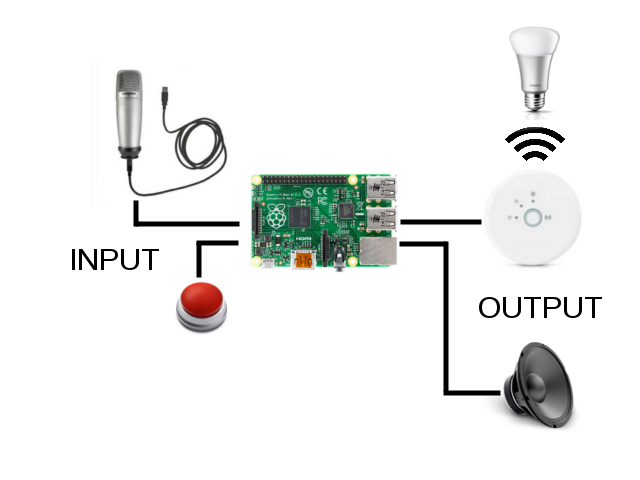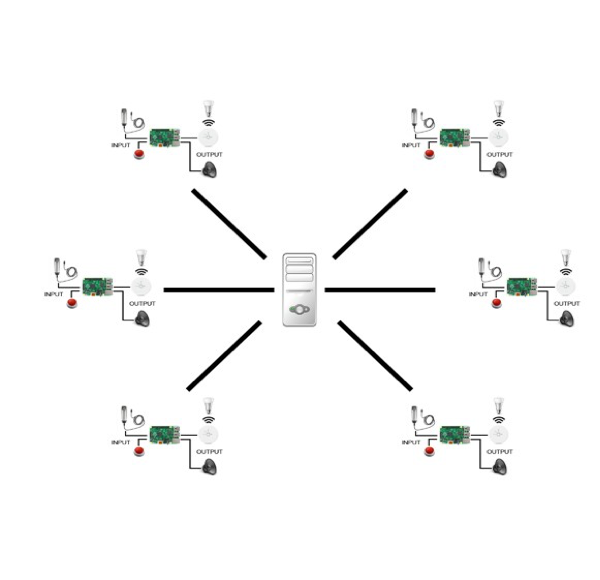Deliverable 1
Vision :
Nobody likes noisy classrooms, and it's always hard to find a quiet place to study especially if you have an exam in the next week. So why not having a system that searches for you the right place to get focused? Our project is exactly what you've been waiting for : NoNoise will help you! It detects the noise level in the classrooms, then a web page suggests you the most silent places where to go. In addition, in the classrooms there is a colorful bulb that gives to the people inside a feedback about how noisy they are, so they can control their voices.
Our system is able to :
- Sense : the noise level is detected directly from sensors in the classrooms
- Reason : the system will be able to compare the noise level with some default thresholds and with other rooms' noise levels
- Act : the actual noise level in a room will be shown through a changing-color led
- Interact : through the measurements the system will be able to suggest the best room available to the user
And, according to the Ambient Intelligence Features, can be:
- Sensitive : the system will be able to sense the ambient noise
- Responsive : the system will output through a led light and on the website
- Adaptive : the system will be able to be put in any classroom with no compatibility issue
- Transparent : the system will be small, light and portable
- Ubiquitous : many sensors will be distributed among the classrooms and all the data will be available on the website
- Intelligent : the system will provide a list of the rooms based on the sensor data
Deliverable 2
Purpose and scope
Nobody likes noisy classrooms, and it's always hard to find a quiet place to study especially if you have an exam in the next week. So why not having a system that searches for you the right place to get focused? Our project is exactly what you've been waiting for : NoNoise will help you! It detects the noise level in the classrooms, then a web page suggests you the most silent places where to go. In addition, inside the classrooms there is a light that changes its colour, as well as a loudspeaker thath produces sound, to give the people inside a feedback about how noisy they are, so they can control their voices.
Definitions
Glossary
Process : measure the noise level (in db) and compare it with default thresholds and send noise level data to the website.
Light : Simple lamp or hue bulb lamp.
Student : a student seeking for a quiet place to study and students already in rooms.
Silence : noise under a certain threshold (that has to be defined).
Room : Classrooms.
Server : A computer connected to polito wi fi and running the python server code.
Actors
The main target user of our project is the student looking for a quiet room to study. We want to help him to find a silent place. Related to this, the secondary actors are the people already in the classrooms. We want to persuade them to keep silence.
System Requirements
Functional Requirements
| FUNCTIONAL AREA | DESCRIPTION |
| 1 | System senses the noise in the classrooms |
| 2 | Public web page visible by any user where the silent rooms are suggested |
| 3 | Color of the light changed by the system |
| 4 | Sound emitted by the system |
| 5 | Switch to be changed to stand-by the system for a while. |
- FR 1.1: Noise data
- Priority 1
- The audio data coming from the room is processed real time.
- FR 2.1: Updating
- Priority 3
- The web page with the informations about the classrooms is updated every 5 minutes
- FR 2.2:Website Layout
- Priority 2
- The website must update its informations and make a chart of the most silent places.
- FR 3.1: Colors
- Priority 1
- The colors of the lamp changes green to red, for low to high noise intensities respectively
- FR 4.1: Sound
- Priority 2
- The sound emitted is a pre-recorded phrase that is played once every time the noise is over the highest treshold.
- FR 5.1: Teacher interaction
- Priority 2
- The teacher can use a switch on the desk to stand-by the system if needed.
- FR 5.2: Stand-by
- Priority 3
- During the stand-by the lights are shut down and the system emits no sound.
Non Functional Requirements
- NFR 1: Portability
- Priority 2
- The system must be light (less than 1kg) and easy(less than 15 minutes) to set in classrooms.
- NFR 2: Compatibility
- Priority 1
- The website must be visible and easy to read on smartphones' browsers (Safari for iphone and default android browsers) for students searching for a quiet room; and it will be in english.
- NFR 3: Dependability
- Priority 1
- the sytstem will depend from current plugs and polito wifi(ladispe AmI wi fi) connection.
Deliverable 3
1. System Architecture
The system architecture is composed as follows :
-
There will be a noise level analyzer in every room that collects and send data to a central server through the Politecnico Wi-Fi network.
The goal of the central server is to receive noise level data from each room and publish this list on a web page updated every 5 minutes.
The peripheral branches of the central server are all the noise level analyzer devices : their main goal is to measure the noise level
and send it the central server.
The actual noise will be measured in each rooom trough a microphone connected via USB to a Raspberry PI that runs a Phyton code to
establish how strong this signal is.
Depending on the strenght of the noise the raspberry will change the color of a HUE bulb to let the users (students in a room)
know how noisy they are being. The HUE bulb is connected to the raspberry trough its own HUE wi-fi hub; there will also be a
speaker playing a default sound when the noise reaches a certain threshold.
A button will allow to turn the raspberry on and off.
The peripheral branches are :

The central branch is :

- The user interface involved in this project is mainly a web page, ideally optimized for smartphones, that shows all the info to a student searching for a silent room (targeted user).
1.1 Hardware Architecture
The main computational node will be a server that receives data from all the nodes in the classrooms and keeps a web page updated. There will be a node in every classroom consisting of a raspberry connected to all the local sensors/actuators: an usb microphone, a gpio (ad-hoc) stand-by switch, an HUE bulb (+HUE bridge) and a speaker. The main user interface will be the website, accessible from most of browsers. The user will also be able to stand-by the peripheral device through the button.
1.2 Software Architecture
Each raspberry will run a phyton code to analyze the sound input from the microphone, detect the noise level and send the data to the central server (through HTTP POST). It will also control some local output (the HUE bulb and the speaker) through the proper phyton APIs. The central node will receive all the data from the nodes and host a web page, keeping it updated through phyton and flask.
2. Selected components.
2.1 Hardware components.
* Raspberry Pi --- Available
* GPIO Switch --- Ad-Hoc
* USB Microphone --- Available
* Hue Bulb + Bridge --- Available
* 3,5mm jack speaker --- Available
2.2 Software Components
* Python 2.7 + PyAudio + NumPy
* Flask
* Rest
* Hue Bulb API
* HTML
open issues
The technologies needed for the project must be defined.
The project needs a cloud service provider.
The software architecture has to be decided.
open issues 3.0
Create an Ad-Hoc GPIO Switch
Choose the sound to be played from the speaker
Define a server architecture for the web output